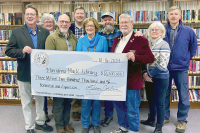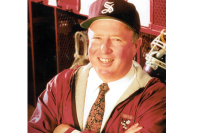Did you miss it? Local lost and founds include some odd, poignant items
Courtney Hall pawed through a cardboard box wedged in the corner of the utility closet at Panacea Coffee Shop bearing cut-out letters from a magazine pasted in an artistic rendition of the infamous words: “Lost and Found.” Inside was the usual assortment you might expect: jackets, keys, sunglasses, a kid’s stuffed animal.
“There is always lots of umbrellas, which come in handy to loan customers if they get stuck here in the rain,” said Hall, manager of the Waynesville coffee house and roastery.
One coffee shop in Sylva took the communal lost and found a step further. They displayed their full smorgasbord of lost reading glasses to pinch hit for customers who forgot theirs.
Meanwhile, at the upscale Old Edwards Inn Resort and Spa in Highlands, Julie Sratton scrolled through the pages of a computer database cataloging items left behind by guests.
“From baby blankets to diamond earrings and Rolex watches,” said Stratton, the head of housekeeping.
Stratton keeps the items under lock and key, safeguarding a clearly more luxurious collection — complete with golf shoes and wedding rings — in a dedicated cabinet.
Related Items
Regardless of the receptacle, lost and founds — millions of them across the country — work to connect people with thousands of their dearly departed items each day.
Humans have been losing stuff as long as they’ve walked the planet. Just ask archaeologists. No sooner had homo sapiens’ precursors begun fashioning tools than they began dropping them about the savannah. The archaeological record is littered with misplaced arrowheads, spear points, bone earrings, and stone pestles long ago separated from their mortar.
“Wherever people are, they can lose stuff,” summed up Florie Takaki, a park ranger at the Oconaluftee Visitor Center in the Great Smoky Mountains National Park, where several thousand items work their way through the system every year.
The top 10 list of any lost and found tells you a lot about what goes on at the place. Coffee shop? It’s reading glasses. The library? Thumb drives from the computer terminals. An arsenal of lost walking sticks reside in the Great Smoky Mountains National Park.
At the gym, think water bottles.
“They lose their water bottles 500 times a day,” said Tamara Medford, a receptionist at the Waynesville Recreation Center.
Ingles grocery store racks up a fair number of canes. People loop them over their grocery carts and then drive off without them, said Spencer Richards, co-manager of the Waynesville Ingles.
At Cataloochee Ski Resort, the winner goes to gloves — single gloves, that is.
“I’ve got a slew of single black gloves — not a pair, it’s always one glove,” said Laura Brown, a receptionist at the ski area who’s the keeper of the lost and found. Of course, that’s not all.
“Right now I’ve got one shoe, a couple of jackets, an ungodly amount of keys, goggles, sunglasses. I even have a bullet and flask,” Brown said. “You would be amazed at some of the stuff.”
It’s comforting, if you can get over the innate human tendency to lose things, that society has banded together to reunite people with their copious volumes of lost stuff.
Despite this ingrained societal arrangement to turn in found items to the nearest lost desk near you, some lost-and-found stories are truly exceptional. Take the man who walked into the Waynesville Police Department with a wallet he found on the side of the road. It had $600 in cash, all still there.
“We tried to run after him when we realized it was full of cash so someone could thank him, but he was gone,” Police Chief Bill Hollingsed recalled.
Turns out, the man who lost it set it on the hood of his car in the Walmart parking lot and drove away, the wallet landing a quarter-mile down the road.
Not everything that ends up at the police department has the allure of wads of cash. Try a day planner from six years ago still languishing in the cardboard lost-and-found box kept in a corner of the dispatcher’s office.
“I am sure whoever lost it doesn’t need it now,” said Kristie Holcombe, the records clerk who works the front window of the Waynesville Police Department.
Their top item? Purses — presumably stolen, pilfered through, then ditched out a car window — now missing their wallets and anything of value, save the random collection of chapstick and gum wrappers known to hide in the bottom of women’s purses.
Innocence lost
Children excel at losing things. No lost and found is complete without a few toys. Stuffed animals, dolls, action figures, baby teething rings, race cars — and most tragically, at least to the parent trying to put their child to bed the fateful night its absence is discovered — security blankets.
Teens, however, might well lead their younger counterparts. Just ask Laura Brown at Cataloochee Ski Area. The morning after night middle school races, there will undoubtedly be a few left snowboards, a rather large and obvious item that clearly accompanied the teen when arriving at the ski area.
Teens don’t go long without realizing their cell phone is lost, however. Tamara Medford at the Waynesville Recreation Center doesn’t even bother putting them in the lost and found box when they get turned in after a basketball game. She just leaves them laying beside her at the reception desk, knowing a panicked teen cut off from their social sphere will be back within minutes.
Cell phones are a popular item in just about any lost and found.
“I’ve had four people in one day say I’ve lost my iPhone,” said Brown at Cataloochee Ski Area.
The ski patrol is often pressed into service scouring the slopes below the chairlift for dropped cell phones — the result of people texting or taking picture with their phones on the ride up the mountain.
The ski area faces an unusual problem with lost items on the slopes.
“If we are making snow, it gets covered up and gets skied over,” Brown said.
When the mounds of snow melt in the spring, the soggy, bare slopes are strewn with phones, hats, credit cards and keys that escaped from the pockets of skiers’ jackets and bibs.
Of course, the keys do little good at that late date. Someone long since found themselves in a pickle — stranded after a day of skiing with no way to get back home. Family members have to drive in from other states with a spare set, or overnight keys in the mail.
Lost in the bureaucratic maze
The nine million visitors who tromp through the Great Smoky Mountains National Park leave so much stuff behind, scattered over the park’s half-million acres, the park has honed an impressive system for matching up lost items to their owner.
If anyone could create a bureaucracy surrounding lost-and-found items, leave it up to the federal government. The park gets several thousand lost or found items in a year, turned in from helter-skelter locations across the park, from backcountry campsites to visitor center bathrooms.
“You can get five or six pairs of reading glasses in an afternoon,” Park Ranger Takaki said.
There are found forms and lost forms that accompany every item, information that gets entered into a database in hopes of matching up the right item with the right owner.
Tourists are often back home before they realize what they left, or at the very least have moved on to the next stop in their vacation before they mount an inquiry to find their lost things. Matching up the correct single earring among dozens that are turned in isn’t always easy when owner can’t come in and offer a visual ID.
Rangers working at various outposts in the park courier lost items back to a warehouse at park headquarters, where they sit waiting to be matched up. Enter more bureaucracy. The rangers shuttling the lost items around the park have to fill out more forms when they take the lost item into their possession and another one when they turn it over to the park’s lost-and-found maestro at the warehouse.
“Chain of command,” Takaki offered.
Some of the things are unique to a national park, left behind by backpackers and brought in days later by other hikers.
“Maps, guide books, pots or pans, things like that you would have in the backcountry,” Takaki said.
But, most of the stuff is just stuff — rings, watches, wallets, cell phones, jackets.
Some items tug on the heartstrings more than others. For Takaki, she still can’t shake a child’s single Oshkosh shoe that turned up one day. It never was claimed.
It’s a reminder that, try as we might, there are millions of once highly-personal things wasting away in boxes and storage lockers in the country’s vast yet imperfect network of lost-and-founds.
And then, there’s those items that just seem to hang on, becoming a fixture of the place where they were left. At Panacea Coffee Shop in Waynesville, a mauve fleece vest had taken up permanent residence behind the coffee counter for weeks before Courtney Hall ferreted out the mysterious loitering jacket.
“We all thought it was each others so we didn’t move it. I kept thinking, ‘Why isn’t Leah taking her fleece home?’” Hall recalled.
One item still hanging on at Panacea is a landscape painting. The local lost-and-found sleuths at the coffee house finally decided it was impulsively purchased at the thrift shop next door and promptly left. It now lives in the attic above the store.
At the Waynesville Recreation Center, the lost and found collects enough gym clothes every few weeks to outfit a whole sports team. They get bagged up and sent to a local charity.
Sweaty gym clothes and wet bathing suits lead to an unfortunate smelly problem. A damp lost and found box would quickly become aromatic, so the staff strung up a makeshift clothesline in the storage closet to hang clothes until they dry out enough to go in the box.
Cataloochee Ski Area has a similar problem. Hats and scarves come in wet from the slopes and start to mildew and stink in short order.
Indeed, lost-and-founds aren’t always glamorous.
At the Waynesville Police Department last week, an officer trying to organize the overflowing lost-and-found box hunted down a pair of plastic gloves before taking on the task.
Hidden treasures
There is something satisfying about reuniting people with their precious things. The lost-and-found guru of any establishment, whether it’s the random box behind the counter of a bakery or an inventoried system as comprehensive as the national park’s, has a touching story to share.
Christine Goralczyk was checking in books left in the drop slot at the Waynesville library one day when she discovered a thin silver bookmark left inside a book. It touched her as being important, so she looked up who had the book out and called them.
“She said ‘I am so glad you got that. My mother gave it to me just before she died,’” Goralczyk said.
Residing in the lost-and-found box at the library this week is a leather bookmark so soft and worn that the writing once engraved on it is no longer legible. It’s been there for months, but the librarians can’t bring themselves to discard it.
“You never know what’s important to someone,” Goralczyk said.
There is something uniquely human, part of our shared experience, that makes us willing to lend a helping hand to reunite that lost item to its owner.
Even when it’s a wad of money, $1,000 no less, found on the bathroom floor of Burger King in Waynesville. Police Chief Bill Hollingsed happened to be eating at Burger King in uniform one day when a man walked up to him and handed him the roll of bills.
Hollingsed launched into a little detective work, asking the workers behind the counter if anyone had inquired about losing money. He didn’t say how much, or what denominations, or even where it was found. A man at one of the tables overheard. He reached up and took off his ballcap and realized he’d just lost his emergency money. The man was a tourist and kept the money under the brim of his ballcap when traveling.
Librarians in Waynesville have another feel-good story, that of a lost-and-found middleman. Someone brought in a wad of keys so big it was unclear how anyone could have ever lost them, said Librarian Christine Goralczyk. The keys were found on the courthouse steps, but luckily, the person had their library card on their key ring and the librarians looked the person up.
Tourists and their cameras are constantly parting ways in the Great Smoky Mountains National Park.
“The heartbreaking part of that is it is not the camera but the memory disc inside,” Takaki said. Hundreds of photos spanning the past year of someone’s life may be inside the camera.
Takaki is always hesitant to troll the photos on someone’s camera in hopes of finding identifying information, but on one camera, she found a picture of someone’s airline tickets, apparently a creative effort to document their vacation for a future scrapbook.
Takaki enlarged it to get the names on the tickets, called the airline and was able to contact the family. Turns out, they had taken off on vacation following their kid’s college graduation and were ecstatic to get back the precious graduation pictures.
As the self-described “keeper of the lost and found” at Old Edwards Inn, Stratton has learned one thing well.
“It is not the monetary value of it but the sentimental value,” she said.
Stratton recalled a woman who called devastated over a watch she was certain she’d left behind after a stay.
“She was crying. She had it for 50 years. Her husband gave it to her and she wore it every day,” Stratton said. They tore her room apart and found it under the headboard of the bed. Stratton’s housekeepers now keep flashlights on their room cleaning carts to look under the beds.
One time, a new bride who got married at the inn left her wedding ring in the bottom of a plastic disposable garment bag her wedding dress was carried in.
Stratton logs every item, lost or found, into a searchable database kept on the resort’s server that anyone working the front desk can search.
The likelihood of losing stuff multiples exponentially at hotels. People come with lots of stuff in tow, are packing and unpacking it, and leave a mountain of it in their wake.
“On an average month in the summertime, we can find 200 items,” Stratton said. “A lot of times when people take vacation, I think they leave their brain at home.”
Helping families find a link to the past
Stan Smith is an expert at finding lost things — in particular, lost graves.
Smith has inventoried more than 200 cemeteries in Haywood County, some of which are little more than a motley collection of unmarked stones deep in the forest or perched on the hillside above an old farmstead.
His treks have taken him through cow pastures, across hay fields and up steep mountainsides to capture the GPS coordinates of historic family cemeteries before it is too late. In the 1880s, graves were often marked by fieldstones with no engraving to speak of. They have since been knocked over, rolled over, moved around and generally jostled by time.
Smith recalled one family who decided to reset all the fallen stones in their family plot of eight graves.
“If they didn’t get it right it was at least within a few feet,” Smith said. “Another family has taken a different approach. They put a group marker at the entrance to the cemetery site saying who was there. They don’t where the graves are, but they do know they are in this particular area. Also, they just keep them clean.”
Smith specializes in helping people find the old graves of their ancestors. He keeps regular volunteer hours at the genealogy desk of the Waynesville library on Fridays, where his services see an uncanny demand.
Curiosity, plain and simply, is usually the driver.
“They want to know where they are buried to visit the marker and know this is where aunt whatever her name was was buried,” Smith said.
Reunion answers questions for mom, daughter
Since she could talk, Whitney Burton knew she was adopted. Her parents were upfront from the beginning, avoiding any kind of earth-shattering revelation down the road that her parents didn’t technically give birth to her.
But she didn’t really realize what that meant until her teen years — that somewhere out there was a biological mother she’d never met.
“When we would go to some really big place like Disney Land or a concert or a baseball game, I remember thinking I wonder if she is here, I wonder what she looks like,” said Burton, 30, who lives in Waynesville.
Still, “it wasn’t really something that played out a whole lot in my day-to-day life,” she said.
Besides, there wasn’t much to do about it. Adoptions in the 1980s were traditionally closed — meaning the parents and birth mother never learn each other’s identity. Even Burton’s original birth certificate had been redacted and replaced with one bearing the names of the parents who adopted her.
“It is a very needle in a haystack situation,” said Burton, an advertising sales representative at The Smoky Mountain News.
But the internet changed that. One night, while cruising the internet her sophomore year in college, she found a web site that keeps a database of biological parents looking for children they had given up for adoption. Armed with only the name of the hospital she was born in and her birth date, Burton gave it a shot and in a heartbeat, there it was. Someone had been looking for a baby girl born that same day in that same hospital.
Her search began as a whim of sorts, but Burton suddenly found herself face to face with the name and address of her birth mother.
“I always thought if I wanted to find her it would take years and a private investigator, not 15 minutes on the internet,” Burton said.
Burton turned to her mother for advice on what to do next.
“She said if you are going to go any further with this, what do you want? What do you want from her?’” Burton recalled her mother asking. “I said I don’t want that feeling of the next time I go somewhere crowded looking around and wondering if she is standing right next to me.”
That, and sheer, inscapable curiosity that is part of the human psyche.
“What does she look like? Is she the same height as me? Do we have the same eyes? I wanted a better picutre of who she was,” Burton said.
Burton mulled it over for several months, and finally decided to write her a letter and included her email address at the bottom. Within days, her biological mother emailed her. They proceeded cautiously, wading into thie uncertain emotional territory in the ultimate lost-and-found quest of a mother who gave her baby girl up for adoption and a curious young woman full of unanswered questions.
If you’re wondering, Burton’s biological mother was young, alone and scared when she got pregnant, and gave Burton up in hopes she’d have a better life.
They spent the next two years occassionally writing and talking on the phone before finally deciding on a face-to-face meeting. Burton boarded a plane to Florida to spend a week with her biological mother, grandparents and a half-sister she’d never met.
These days, Burton gets a birthday card once a year from her biological mother. For now, the two are good with that.
“I think we both got what we needed. She needed to know she didn’t make a mistake, that I had a good life, that I had a good family. I wanted to know a little bit about her so I wasn’t always wondering.”









